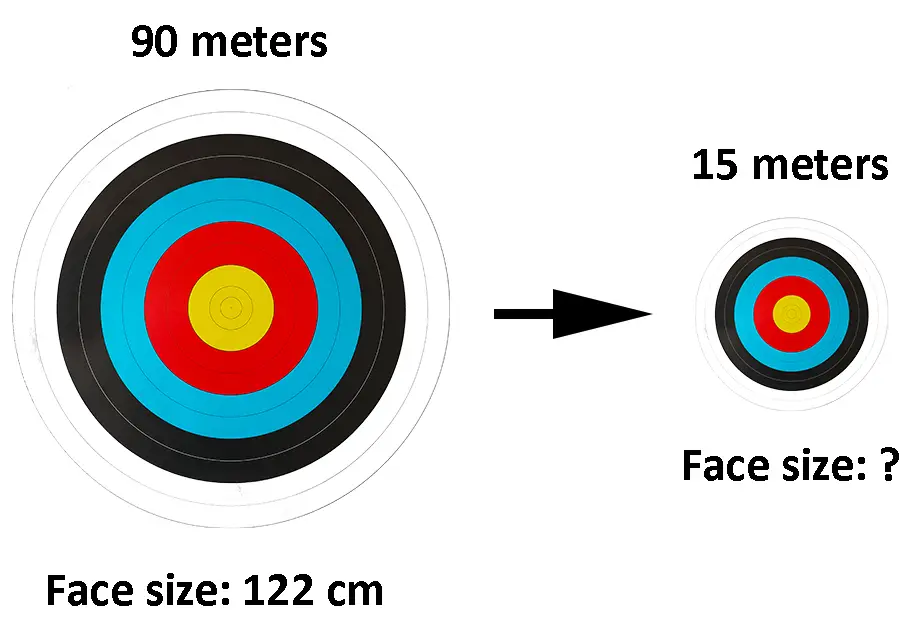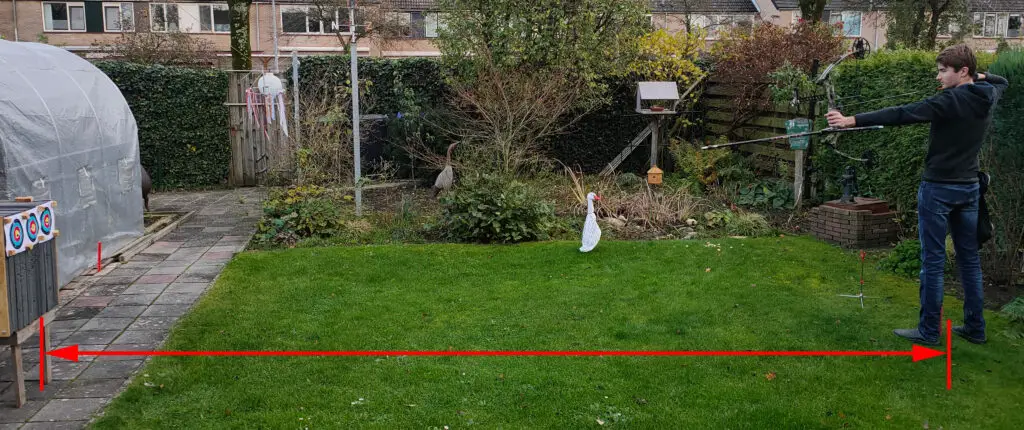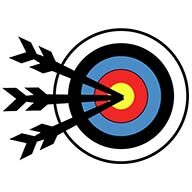Bookmark or save the link to this page, so you can use it again later!
Video demonstration
What this tool does
This tool allows you to calculate how big your target face should be to make it comparable across distances. See the example below:
Let’s say that you normally shoot at a distance of 90 meters on a 122 cm target. How big should your target be at 15 meters to make the results comparable? This tool allows you to calculate it.

Why use this tool?
A lot of archers practice in their backyards. It allows you to train without having to go to your local archery club. Depending on your backyard you might shoot at 5, 10, or 15 meters. In those cases, shooting at a large target will not be fun. You will hit the yellow without a real challenge.
Therefore, you have to shrink your target to make it fun and challenging. With this tool, you can calculate exactly how big your target face should be. Therefore, you recreate the conditions on the field which makes for better training.
How to use the tool
Step 1: Before you can use the tool you should decide what target face you want to reference. Do you want to use a 122, 80, or 40 cm target face? You can also measure the outer ring of your target face, in case you don’t know the dimensions. This has to be in centimeters, you can convert inches to centimeters here.


Step 2: Next fill in the distance between you and the target. The most common distances in target archery are 18, 30, 50, 70, and 90 meters. In case you are used to yards, use this tool to convert them to meters. Also, don’t use centimeters or decimeters in this tool. Otherwise, you will get really weird results.
Step 3: Now measure the distance you can shoot your bow at in your garden. Measure from the front of the target to the shooting line. Again, only use meters in this section.

Step 4: Click on next, and you will see how large your new target should be. You can always press the restart button to take new measurements. If you want to use decimals, use the point (.) and not the comma (,). Otherwise, the tool will say that the questions haven’t been answered validly.
Step 5: Now download a target face, for example, from this website. Then resize it to the recommended diameter with the editor in word or Google Docs and print it. You can now use this target to compare it to your reference target.
The limits of the tool
Although this tool helps you to more closely replicate real field shooting conditions, you can’t 100% compare scores with your reference target.
Because we only adjust the diameter of the target and not the diameter of the arrow, you might get higher scores than you would have on the field. The only way to solve this issue is to shoot with shashlik sticks instead of arrows, so that isn’t really an option.
Additionally, the arrow will also experience more drag and turbulence from the wind which can throw off your shot. That is unlikely to happen when you shoot at a short distance.
Finally, arrows tend to flex quite a lot the first few meters after being fired. This can sometimes be unpredictable and decrease your accuracy.
In general, the results are less comparable the bigger the difference between the distance of the reference target and the new target. A comparison between 5 and 90 meters will be less fair than 10 and 18 meters. So consider these things when comparing your shots.
Final words
I hope this tool is helpful for your target practice. I developed this tool in the midst of the COVID-19 crisis. I wanted to compare my shots at 5,5 meters with the 40 cm indoor target face. I noticed that it was difficult to evaluate how well I was shooting because the target face wasn’t resized.
I started experimenting with different target face sizes and I printed these on A4 paper. Then I started taking measurements and came up with this formula:
(Original target size in cm / (Original target distance in meters * 100)) * (New target distance * 100) = New target size
I made this tool so you and I don’t have to fill in this formula every time we want to make a comparison. Feel free to use my work, but please credit me (ImproveYourArchery.com). Just send me an email if you want to incorporate this tool on your website or platform.
If you have any questions, comments, or feedback, please let me know in the comment section below. I will answer as soon as possible and you will receive an email notification.
Tim van Rooijen
For as long as I can remember, I have always been fascinated by archery. First due to its historic significance but later because I like being outdoors. With this blog, I share my knowledge about Archery and how you can improve your shot. More about author…


Thankyou for this article.
have wasted a few larger than needed targets at a short range, and as you said, grouping in the 10 at a short distance on a ‘full size’ target doesnt help when it comes to shooting the same target, at a longer distance.
Hi Scott, I am happy to hear that you find this tool helpful! That’s exactly why I made the tool. You want to mimic the conditions of the field as closely as possible.
This doesn’t take into account the drop of the arrow. How would you simulate long-range arrow-drop in a short distance?
Hi Paul,
Yes, you’re right, this does not take arrow drop into consideration. To compensate for this I normally just move the sight. But do I understand correctly that you do not want to do that?
If that is the case, you could use a second target and place it below the actual target. You will use this target purely for aiming while the other target will be the target where the arrows land. I have heard that there are some tools to calculate how much the arrows drop, but I have not tested them yet.
I do find it an interesting topic, so I will look into it and check if I can come up with anything!
Thank you!
G’day
I was wondering if you would like a simpler formula that doesn’t care if the values are metric or whatever?
=(New distance / Original distance) x Original Target size
The only requirements is that both distances must be in the same measurements ie meters, yards, centimetres, footsteps :), and all values are in decimal point (no fractions).
Useful site
Hi George,
Yes, you are right this is the original formula. We only multiply the meter by 100 to get to centimeters. So if you use the same scale for all measurements you can omit the multiplication by 100.
I am unsure how easy it is to measure your distance in inches or your target size in yards, so I have chosen this approach. I used metric instead of imperial since this is the standard within World Archery. But I might make an imperial version to make it easier for my American readers.